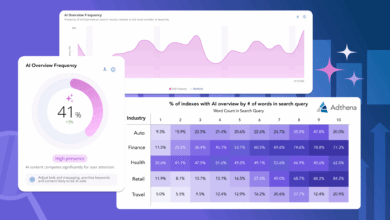Google AI Guides Research, But Search Drives Sales

▼ Summary
– Google’s AI Overviews primarily appear for research and evaluation queries rather than bottom-funnel purchasing searches.
– AI Overview coverage fluctuated dramatically from 26% in September to 9% in October with an 82% year-over-year keyword churn.
– Only 30% of keywords retained AI Overviews after Google’s September pullback, representing a 56.8% overall reduction in coverage.
– Grocery & Food (56%), TV & Home Theater (43%), and Small Appliances (37%) categories showed high AI Overview retention after the pullback.
– Furniture (3%), Home Décor (7%), and Apparel (23%) categories experienced the lowest AI Overview retention rates.
When it comes to online shopping, Google’s AI Overviews serve primarily as research tools rather than direct sales drivers, according to a recent BrightEdge study. The analysis examined thousands of ecommerce search terms between September and October, revealing that AI-generated summaries typically appear during the discovery and evaluation phases of the customer journey. Meanwhile, purchase-oriented searches continue to be dominated by traditional organic results, highlighting where businesses should focus their conversion efforts.
The data reveals significant fluctuations in AI Overview visibility throughout the observation period. Coverage surged to 26% in September before sharply declining to just 9% by mid-October. Despite this substantial pullback, approximately 30% of keywords maintained their AI Overview presence. The analysis also uncovered an 82% year-over-year turnover in keywords triggering these AI features, with only 18% overlap from the previous period. Overall, AI Overview coverage experienced a 56.8% reduction, ten times greater than the decline observed last year.
Different product categories demonstrated varying levels of stability following Google’s September adjustments. Several sectors maintained strong AI Overview retention rates, with Grocery & Food leading at 56% retention. TV & Home Theater categories followed at 43%, while Small Appliances maintained 37% presence. Conversely, some categories saw minimal AI Overview persistence, with Furniture at just 3%, Home Décor at 7%, and Apparel at 23%.
These findings carry important implications for ecommerce strategy. Brands aiming to maximize visibility should recognize that AI Overviews predominantly assist consumers during their research phase. By creating content that answers questions and helps shoppers compare options, businesses can establish themselves as trusted resources. Simultaneously, maintaining strong traditional SEO practices remains crucial for capturing buyers ready to make purchases. The separation between research-oriented AI features and transaction-focused organic results suggests marketers should develop distinct approaches for each stage of the customer journey.
(Source: Search Engine Land)

